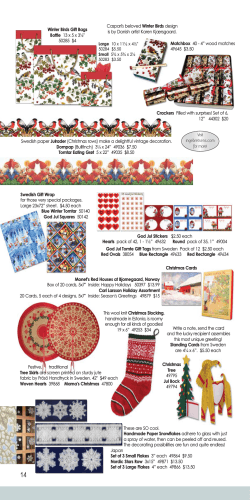
prel program 7 maj_Maithe
Thursday, May 28th 12:00 - 12:50 Registration and sandwiches 12:50 - 13:00 Welcome 13:00 - 13:50 GENES IN CONE DEGENERATION Bernd Wissinger, Centre for Ophthalmology, University of Tübingen, Germany. 14:00 - 15:00 Genetic panorama of hereditary retinal degenerations in northern Sweden. Irina Golovleva, Department of Medical and Clinical Genetics, Medical Biosciences, Umeå University, Sweden. CERKL-mutations: a common cause of autosomal recessive juvenile macular dystrophy in Finland. Eeva-Marja Sankila, Helsinki University Eye Hospital, Finland. Targeted Next Generation Sequencing of 500 patients with retinal dystrophies. Karen Grønskov, Department of Clinical Genetic, Kennedy Center, Glostrup Hospital, Denmark. Novel variants in the polyglutamylase TTLL5 underlie autosomal recessive cone-rod dystrophy and incompletely penetrant male infertility. Nicola Bedoni, Department of Medical Genetics, Faculty of Biology and Medicine, University of Lausanne, Switzerland. The RP-associated protein FAM161A is a component of the centrosome-Golgi apparatus network. Pietro Farinelli, Department of Medical Genetics, Faculty of Biology and Medicine, University of Lausanne, Switzerland. 15:00 - 15:30 Coffee 15:30 - 16:30 Can S-cone waves in Full field ERG be accurate in detecting NR2E3linked retinopathy? SQUH experience. Sana Al-Zuhaibi¹, Vidya Thomas¹, Anuradha Ganesh¹, Mohmmed Al-Abri1, Ahmed Al-Hinai1, Rashid Al-Saidi2, Aisha Khayat3. 1The Department of Ophthalmology, Sultan Qaboos University Hospital; 2The Armed Forces Hospital; 3Department of Genetics, College of Science, Sultan Qaboos University, Muscat, Sultanate of Oman. Foveal structure, ERG changes and CACNA1F mutation spectrum in Danish males with Åland eye disease. Michael Larsen, Marianne Hove, Hanne Jensen, Birgit Sander, Thomas Rosenberg. Department of Ophthalmology, Kennedy Center, Glostrup Hospital, Denmark. Adaptive optics retinal imaging – an overview. Zoran Popovic, Department of Ophthalmology, University of Gothenburg, Sweden. The ABCA4 mutation spectrum in Finnish Stargardt's disease patients. Eeva-Marja Sankila, Helsinki University Eye Hospital, Finland. Reduced macular function in ABCA4 carriers. Ulrika Kjellström, Department of Ophthalmology, Lund University, Sweden. 16:45 - 17:45 Genotype and phenotype in an unusually form of LMBB syndrome. Christina Kamme1, Anja Kathrin Mayer2, Tim Strom2, Sten Andréasson1, Nicole Weisschuh3. 1Department of Ophthalmology, Lund University, Sweden; 2Helmholtz Institute in Munich, Germany; 3Molecular Genetics Laboratory University Eye Hospital Tübingen, Germany. Alström Syndrome geno-phenotype. Claes Möller, Department of Audiology and the Swedish Institute for Disability Research, University Hospital Örebro, Sweden. Genotype-phenotype relationship of disease progression with age in OPA1 autosomal dominant optic atrophy. Cecilia Rönnbäck, Department of Ophthalmology, Glostrup Hospital, Denmark. Bilateral ”coloboma” of the macula. Thomas Rosenberg, Department of Ophthalmology, Kennedy Center, Glostrup Hospital, Denmark. Autosomal recessive bestrophinopathy. Elisabeth Department of Ophthalmology, Lund University, Sweden. 19:15 Wittström, Dinner Friday, May 29th 08:15 - 09:30 GENE THERAPY – GENETICS, CLINIC AND SURGERY Jean Bennett, Albert Maguire, University of Pennsylvania, School of Medicine, USA. 09:30 - 10:00 Coffee 10:00 - 11:00 Xeno-free and defined differentiation of human embryonic stem cells into retinal pigment epithelial cells on specific laminins. Sandra PetrusReurer1,2, Alvaro Plaza Reyes1, Liselotte Antonsson 1, Sonya Stenfelt1, Hammurabi Bartuma2, Sarita Panula1, Theresa Mader1, Helder André2, Outi Hovatta1, Fredrik Lanner1, Anders Kvanta2. 1Department of Clinical Sciences, Intervention and Technology, Karolinska Institutet, Stockholm, Sweden; 2Department of Clinical Neuroscience, Section for Ophthalmology and Vision, St. Erik Eye Hospital, Karolinska Institutet, Stockholm, Sweden. In vivo integration of human embryonic stem cell-derived retinal pigment epithelial cells in a preclinical model. Anders Kvanta2, Sandra Petrus-Reurer1,2, Alvaro Plaza Reyes1, Liselotte Antonsson1, Sonya Stenfelt1, Hammurabi Bartuma2, Sarita Panula1, Theresa Mader1, Helder André2, Outi Hovatta1, Fredrik Lanner1. 1Department of Clinical Sciences, Intervention and Technology, Karolinska Institutet, Stockholm, Sweden; 2Department of Clinical Neuroscience, Section for Ophthalmology and Vision, St. Erik Eye, Hospital, Karolinska Institutet, Stockholm, Sweden. Nanowire-based retinal stimulation. Maria-Thereza Perez1,3, Magnus Borgström2,3, Christelle Prinz2,3, Heiner Linke2,3. 1Department of Ophthalmology, Lund University, Sweden; 2Division of Solid State Physics, Lund University, Sweden; 3Nanometer Structure Consortium, Lund University, Sweden. cGMP in retinal degeneration: new ideas for an old problem. Patricia Veiga Crespo, Department of Ophthalmology, Lund University, Sweden. Restoration of the optic nerve – physical and chemical support for retinal ganglion cells. Ulrica Englund Johansson, Marina Castro Zalis, Sebastian Johansson, Hodan Abdshill, Fredrik Johansson, Department of Ophthalmology, Lund University, Sweden. 11:00 - 11:50 Macular function measured by binocular mfERG and compared to macular structure in healthy children. Anna Molnar1, Sten Andréasson2, Eva Larsson1, Hanna Åkerblom1, Gerd E. Holmström1. 1Department of Neuroscience/Ophthalmology, Uppsala University, Sweden; 2Department of Ophthalmology, Lund University, Sweden. Photopic full-field electroretinography and optical coherence tomography in type 1 diabetic retinopathy. Ragnhild Wivestad Jansson, Department of Ophthalmology, Haukeland University Hospital, Bergen, Norway. Challenges in investigating retinal vasculitis. Beatrice Peebo, Department of Ophthalmology, Institute for Clinical and Experimental Medicine, Faculty of Health Sciences, Linköping University, Sweden. Retinal function after macular hole surgery Fredrik Ghosh, Sten Andréasson, Department of Ophthalmology, Lund University, Sweden. 11:50 - 12:00 Closing remarks and sandwiches
© Copyright 2025











